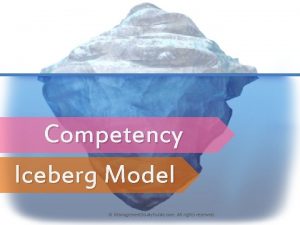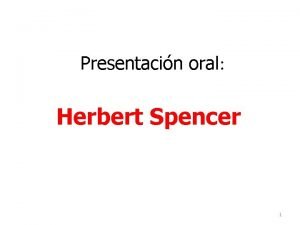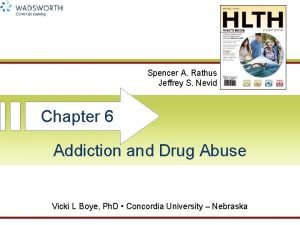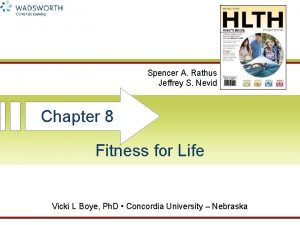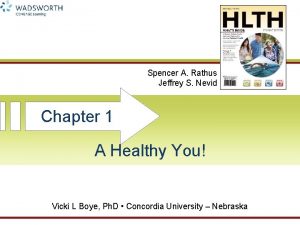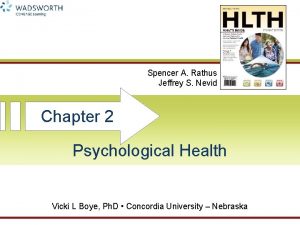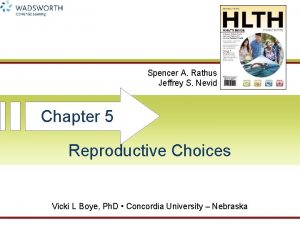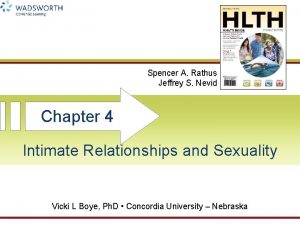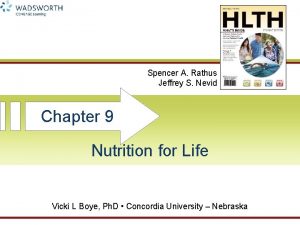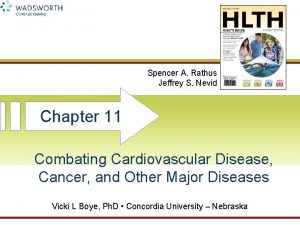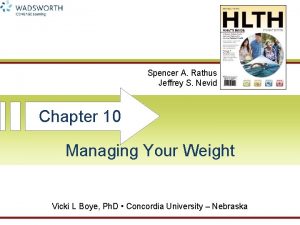Spencer A Rathus Jeffrey S Nevid Chapter 7















- Slides: 15

Spencer A. Rathus Jeffrey S. Nevid Chapter 7 Alcohol and Tobacco Vicki L Boye, Ph. D • Concordia University – Nebraska

Chapter 7 Alcohol and Tobacco Learning Outcomes: § Explain what alcohol is § Explain which segments of the population are most likely to drink § Describe the effects of alcohol § Define alcohol abuse and dependence § Discuss the causes of alcoholism § Describe various methods of treating alcoholism § Explain which segments of the population are most likely to smoke § Describe the effects of smoking on health § Discuss the health benefits of quitting smoking

Alcohol • Colorless, flammable liquid • Ethanol – psychoactive chemical • Considered safe to drink in moderate amounts • Produced using fermentation (beers and wine) or distillation (hard liquors) • Alcohol content or strength measured by proof Proof is twice alcohol content (80 proof=40% alcohol)

Who Drinks & How Much § Two-thirds of U. S. adults drink alcoholic beverages § 1/2 are light drinkers; ½ are moderate or heavy drinkers § Alcohol use most prevalent among 21 -34 year olds § European Americans most likely to use alcohol; men are more likely to drink than women § More than half of underage adolescents have used alcohol in the last year § College students § 4 out of 5 students drink, typical student consumes more than 35 gallons of alcoholic beverages each year § 40% report binge drinking in the past 30 days § Adverse effects: academic, sexual activity, other high risk behaviors

Effects of Alcohol Physical Effects: • Depressant drug • “intoxication” • balance, speech, coordination, vital functions – slowed, could become depressed leading to unconsciousness or even death • Factors influencing effects: • gender, weight, tolerance, food in stomach, amount and rate of drinking

Effects of Alcohol Behavioral Effects Dependent on amount consumed; judgment impaired • Sexual Behaviors • Inhibitions may decrease but sexual response may be impeded • Violence • • Alcohol connected to over ½ crimes reported on campus Put people at greater risk for being victimized

Health Effects of Heavy Drinking • Linked to premature death before 65 males 2 x the risk females 3 x the risk

Alcohol Abuse & Dependence Alcohol Abuse: A pattern of heavy or continued drinking that becomes linked with health problems or impaired social functioning. Underage use, drinking games Alcohol Dependence (alcoholism): A state of physical dependence, or addiction to alcoholism, that is characterized by loss of control over it’s use. Body changes in how it responds, biological craving, tolerance and/or withdrawal syndrome develop Delirium tremens – extreme restlessness, sweating, disorientation, and hallucinations

Causes & Treatment of Alcoholism Disease Model: permanent, irreversible physical condition “once an alcoholic, always an alcoholic” Genetic Factors: - sons of alcoholics 4 x greater chance of becoming alcoholics - genes linked to tendency for greater pleasure from alcohol or greater tolerance for negative effects of drinking Other Factors: Contribute to problem drinking Peer pressure, families with lax control or lack of emotional support, single-parent homes, exposure to parents who drink, use of alcohol to self-medicate

Treatment of Alcoholism First step of recovery is recognition of the problem • Treatment options • Detoxification • Alcoholics Anonymous • “recovering alcoholic” – no cure • Psychotherapy and Counseling • Social skills training, aversive conditioning, relapse prevention training • Pharmacological Treatment • Disulfiram (antabuse) – produces nausea, sweating, flushing, headache, if you drink

Tobacco • No medicinal use or safe way to consume • Smoking accounts for 1 in 5 deaths in the U. S. • Contains nicotine – stimulant • Highly addictive – 1/3 of those who tries cigarettes become regular smokers • Who smokes? • Men more than women, although women < 30 fastest growing group • People with less education – more likely to smoke, less likely to quit • Lower socioeconomic status • Ethnic minorities, especially African-American males

Other Forms • Pipe and Cigar Smoking • Don’t inhale or inhale as deeply, still risk from carcinogens • At greater risk for oral cancer than cigarette smokers • Side-stream smoke contain higher levels of carcinogenic particles • Smokeless Tobacco (chew or snuff) • Nicotine passes through mucosal membranes of nose or mouth into bloodstream • Responsible for 3 out of 4 cases of oral cancer • Sidestream Smoking (passive or second-hand) • Contains greater concentration of carcinogens • Can cause heart disease, lung cancer, increased respiratory problems including asthma – especially in children

Reasons for Smoking • Addiction • Leading form of addiction in our society • Associated with tolerance and withdrawal syndrome • Control Weight • Nicotine suppresses appetite and raises metabolic rate • Relieve Anxiety or Depression

Effects of Smoking on Health • Life expectancy cut by: • 13. 2 yrs for males 14. 5 yrs for females • Risk of dying prematurely from a smoking-related cause increases by 50% • Lung cancer risks increase 23 x for males, 13 x for females • Smoking accounts for 80% of deaths from COPD • Women who smoke are at higher risk for • Early menopause • During pregnancy – miscarriages, premature birth, low birth weight, birth defects • Appearance – smoker’s face

It is never to late to quit
 Psychology principles in practice
Psychology principles in practice Nevid insekt
Nevid insekt échelle des standards personnels de frost
échelle des standards personnels de frost Spencer 1993
Spencer 1993 C petracca
C petracca Modello iceberg di spencer e spencer
Modello iceberg di spencer e spencer Matrice delle competenze
Matrice delle competenze Spencer and spencer 1993
Spencer and spencer 1993 Iceberg model competency
Iceberg model competency Percy spencer invented the microwave
Percy spencer invented the microwave Karl marx sociology
Karl marx sociology Herbert spencer social darwinism
Herbert spencer social darwinism David lozano zaragoza cultural
David lozano zaragoza cultural Infrspinatus
Infrspinatus Parent de diana spencer
Parent de diana spencer What is antineutrino
What is antineutrino








